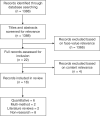The use of simulation as a teaching modality for paramedic education: a scoping review
- PMID: 33456395
- PMCID: PMC7783959
- DOI: 10.29045/14784726.2020.12.5.3.31
The use of simulation as a teaching modality for paramedic education: a scoping review
Abstract
Background: Simulation is a broad concept used as an education pedagogy for a wide range of disciplines. The use of simulation to educate paramedics is a frequently used but untested modality to teach psycho-motor skills, acquire new knowledge and gain competence in practice. This review identifies how simulation is currently being used for the education of paramedics, and establish the context for future application.
Methods: A scoping review of the literature was undertaken following the PRISMA systematic approach. Flexible inclusion criteria were used to capture research and non-research articles that would contribute to the synthesis of literature with a specific knowledge base pertaining to simulation use for paramedic education.
Results: Initial searching yielded 1388 records, of which 22 remained after initial title and abstract reading. Following secondary full-text screening, 18 articles were deemed appropriate for final inclusion: eight are research, two literature reviews and eight non-research. Across all the literature, a range of concepts are discussed: Skill vs Scenario, Virtual Learning, Inter-Professional Learning, Fidelity, Cost, Equipment, Improvement of Competency, Patient Safety, Perception of Simulation.
Conclusion: It is evident that simulation is a primary teaching modality, consistently used to educate and train paramedics. Simulation is inherently effective at teaching clinical skills and building student competence in particular areas. Similarly, simulation is effective at providing paramedics with experiences and opportunities to learn in varied environments using differing techniques. This allows students to apply the relevant skills and knowledge when faced with real patients.
Keywords: education; paramedic; simulation; teaching.
© 2020 The Author(s).
Conflict of interest statement
None declared.
Figures
References
-
- Alinier G., Harwood C., Harwood P., Montague S., Huish E., Ruparelia K. & Antuofermo S. (2014). Immersive clinical simulation in undergraduate health care interprofessional education: Knowledge and perceptions. Clinical Simulation in Nursing, 10(4), 205–216.
-
- Association of Ambulance Chief Executives (AACE). (2011). Taking healthcare to the patient: Transforming NHS ambulance services. http://aace.org.uk/wp-content/uploads/2011/11/Taking-Healthcare-to-the-P....
-
- Birt J., Moore E. & Cowling M. (2017). Improving paramedic distance education through mobile mixed reality simulation. Australasian Journal of Educational Technology, 33(6), 69–83.
Publication types
LinkOut - more resources
Full Text Sources

